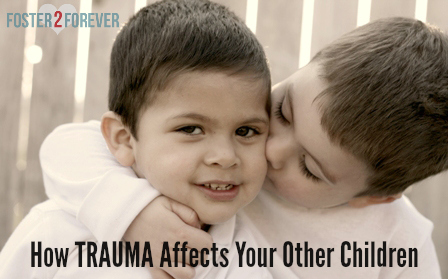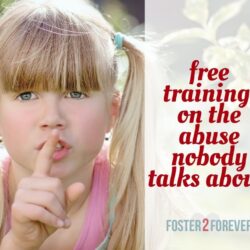If you bring traumatized children into your home, the traumatic events that they suffered through can take its toll on you, the caregiver, even to the point that you can begin to suffer from secondary traumatic stress (STS). Read more on STS and stress management tips.
Secondary traumatic stress occurs when someone is repeatedly exposed, directly or even indirectly, to trauma or suffering. Secondary trauma develops due to the stress the parent or caregiver experiences from helping or wanting to help a traumatized child. Sometimes a foster parent or caregiver can even be at risk of developing the same symptoms as the child directly affected by the trauma. A person is especially vulnerable to secondary trauma stress if they’ve experienced previous trauma.
But as a foster/adoptive parents, we understand how living with trauma affects us, but we are just beginning to realize how raising a traumatized child is traumatizing our other children. Children are especially susceptible to secondary trauma because of their limited ability to understand the traumatic experiences surrounding them. Young children struggle to make sense of trauma and are completely dependent on adults for their emotional and physical needs.
To me, it doesn’t seem that adoptive families have truly been informed about this ripple effect of trauma. I know I wasn’t. Sure, trauma-informed care is just now beginning to be discussed in foster parent training, but many of us became foster parents before this latest buzzword began making the rounds.
Trauma affects everyone in the home.
 When my son, JD, was a toddler, we added another baby boy to our family. We were excited for JD to have a brother to bond with and have as a companion growing up and into adulthood. They are brothers and love each other. When one gets in trouble, the other takes up for him. However, we didn’t know the extent of JD’s trauma, and how that trauma would affect our family.
When my son, JD, was a toddler, we added another baby boy to our family. We were excited for JD to have a brother to bond with and have as a companion growing up and into adulthood. They are brothers and love each other. When one gets in trouble, the other takes up for him. However, we didn’t know the extent of JD’s trauma, and how that trauma would affect our family.
JD’s trauma is intense, although he doesn’t remember his infant neglect, but when he feels hunger or has a drop in blood sugar, his primal fear of hunger takes over and my cheerful, sweet child becomes a totally different person. (He has had his blood sugar tested numerous times, and no physiological problems exists with his blood sugar.)
As the parents, we have struggled through secondary trauma. But what about our youngest? How has growing up under the effects of trauma affected him? Did our baby inadvertently grow up in fear? How did he not?
Signs of Secondary Trauma
Emotional Indicators: anger, sadness, anxiety
Physical Indicators: headaches, tummy aches, constipation
Personal Indicators: cynicism, irritability with family members
As I look through this list, I’m saddened see how each member of our family shows indicators of secondary trauma. What are we doing to help our other child?
Counseling: An important part of healing. We will continue counseling for both our children, of course.
Evaluation: Evaluate your family situation. We are currently taking a break from foster parenting to focus on healing the current members of our family. But before that, our personal standard had become to only add foster children to our family that are younger than our youngest. We’ve learned that trauma shouldn’t be modeled to our younger children.
Individual Attention: Also, because our LilBit has grown up under all this trauma and stress, we’ve made the decision to homeschool him this next school year. Through homeschooling, he will finally receive the one-on-one attention he usually doesn’t get when his brother’s needs overshadow everyone else’s. We are excited about the possibilities of how our homeschool adventure can help heal each member of our family.
Through sharing my struggles of parenting trauma publicly with you, my hope is that you will be truly informed about trauma and its effects on your entire family. I also hope that you seriously evaluate your family when introducing trauma to your young children.
I still advocate foster parenting, but I also desire that both your eyes and heart are open to all that journey entails.





